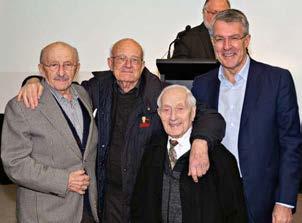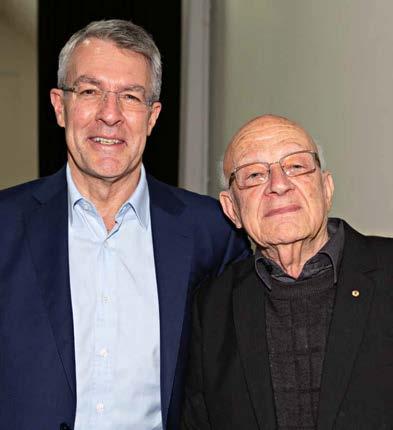
4 minute read
Jewish life in Germany today
Mark Dreyfus
In July, the Jewish Holocaust Centre hosted the travelling exhibition ‘Jewish Life in Germany Today’. The exhibition was brought to Melbourne by the Embassy of the Federal Republic of Germany in Canberra.
Advertisement
In 25 poster panels, the exhibition combined the historical and contemporary aspects of living as a member of the Jewish community in Germany. In concise and striking statements, Jews explain what living in Germany means to them, how the history of the Holocaust influenced their personal lives and the dreams they have for their future in Germany. From students to best-selling authors, to rabbis and entrepreneurs, their biographies reflect the diversity of the German-Jewish community today and are a testament to the transformation that Germany has undergone since the Second World War.
The exhibition was opened by the Hon Mark Dreyfus QC MP. This is an edited version of his address.
It is a pleasure to be here to launch this wonderful exhibition, and to have the opportunity to reflect a little about what this exhibition represents: a kind of Jewish renaissance in a nation that was a place of great importance to Jews, until the horrors of the Nazi regime and its aftermath cast a shroud of darkness over Jewish life there. Because what this exhibition makes so clear is how Jews and Jewish life is once again flourishing in Germany. And that is a wonderful thing to be able to say.
The story this exhibition tells is a story of importance to Jews the world over, and to very many, if not all, Germans. It is a story like so many in Jewish history that is about hope, about resilience and about renewal. And it is a story to which I have a very strong personal connection. It is my father, George Dreyfus, who should be giving this talk because he has had much more contact with Jewish life in Germany today than I have. I have visited Germany, but my father has returned there every year or two since about 1951. In doing so, he has participated in a very real way in making sure that there has been a renewed Jewish presence, including many performances of his compositions – including an opera or two – in Germany.
My father and his parents escaped from Nazi Germany, my father before the war, arriving in Australia with his brother, the late Richard, in July 1939. My father’s parents, my grandparents, arrived, some three months after the war started, in a somewhat miraculous escape from Germany. My great grandparents did not. They perished in the Holocaust.

I have a continuing connection to Germany because all three of my children have taken up German citizenship, not because they have gone to live in Germany but because it is possible for children and other descendants of survivors to take up German citizenship, under a law of return that Germany has made possible.
I think we are all aware of the enormous contribution that German Jews have made to both Jewish and Western thought over the centuries. One could point to intellectuals like Moses Mendelssohn, Rabbi Abraham Geiger, Rabbi Samson Raphael Hirsch and Zacharias Frankel. All had a very significant impact on Jewish thinking and on our religious traditions. You could also point to German Jewish scientists in fields including physics, chemistry and medicine who have had a huge impact on the world, perhaps none more so than Albert Einstein. And in many other fields, as this exhibition reminds us with notes and images of Mayer Rothschild, Kurt Weill, Hannah Arendt, Max Liebermann and others.
Some of the statistics that are included in the exhibition tell the story of Jewish life in Germany with a stark simplicity. Around half a million Jews lived in Germany when the Nazis came to power in 1933. I will not dwell on this, the darkest chapter of Jewish history in Germany, other than to say around 300,000 Jews had left by 1939, a few thousand more managed to escape after the Second World War had started, but around 180,000 German Jews were murdered during the Holocaust, along with millions of others throughout Europe. The enormity of this crime, this loss, this horror, like so much of the Holocaust, can be stated, but not truly comprehended.
Yet the unspeakable enormity of that horror also underpins the remarkable story that this exhibition tells. And the fact that the Jewish community is once again thriving in Germany, still in living memory of the most appalling crimes against it, also speaks of the willingness of German society to confront the demons of its past. Because only by confronting the past has German society been able to make the heartfelt commitments needed to truly welcome Jews back into the German nation, and for Jews to trust that welcome.
At the beginning of the 1950s there were not more than 25,000 Jews living in the Federal Republic of Germany, and only a few hundred in the German Democratic Republic – at least only a few hundred willing to be identified as Jews to that German government. These figures did not change much over the coming decade, so that by 1990, there were still only around 30,000 Jews living in West Germany.
However, then things changed. Through the 1990s and the early 2000s, more than 200,000 Jews and their family members immigrated to Germany from the collapsing Soviet Union. Many were on their way to other nations but many stayed, so that now up to 200,000 Jews are living in Germany, with Berlin again the largest of those communities.
Indeed the Jewish community in Germany is now the eighth largest in the world and it continues to grow and flourish. I find it very heartening that thousands of young Israelis spend time in Germany – some for years – particularly in Berlin. And I also find it heartening that the state of Israel finds a loyal friend in the Federal Republic of Germany.
This exhibition provides a beautiful tapestry of how the flourishing Jewish community in Germany now looks. The diversity of the Jews that are represented tells us that there is a vibrant Jewish life in Germany today.






